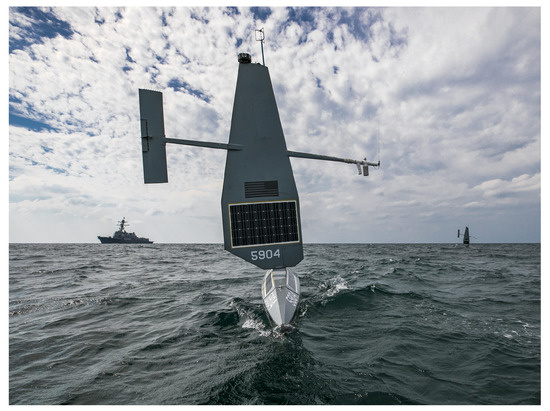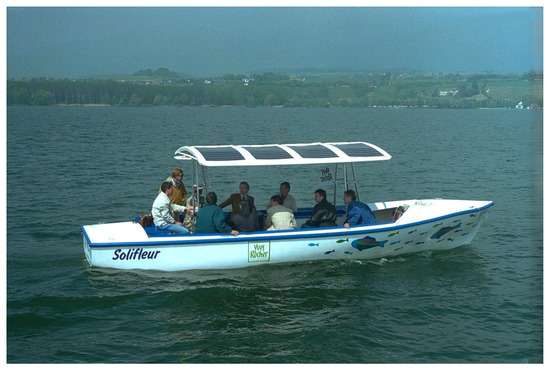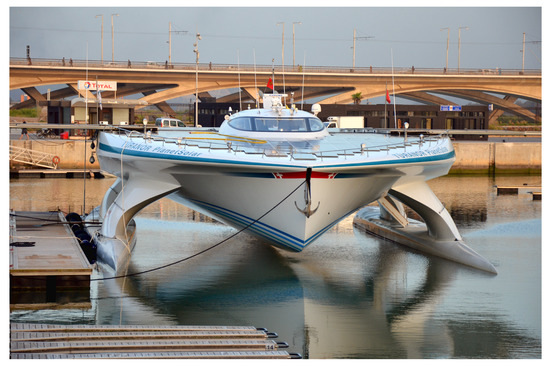You're using an outdated browser. Please upgrade to a modern browser for the best experience.
Please note this is a comparison between Version 2 by Giangiacomo Minak and Version 1 by Giangiacomo Minak.
Solar energy-powered boats have emerged as a noteworthy solution for environmentally friendly transportation, starting with Alan T. Freeman’s pioneering solar boat called Solar Craft 1 in 1975. These boats have garnered increasing interest from esteemed boatyards, universities, and research centers worldwide, as they address the need for eco-friendly transportation (refer to [7] for a recent review on the life cycle assessment of PV panels).
- solar energy
- photovoltaic panels
- electric boats
- Marine Drones
1. Maritime Drones
In recent years, autonomous vehicle studies have expanded across various domains, including aeronautics, automotive, and maritime applications [18,19]. Solar-powered autonomous surface vehicles (ASVs) offer the advantage of not requiring refueling or recharging at their base (port or mothership), thus potentially extending their mission’s temporal and, in some cases, spatial range.
Maritime drones are primarily utilized for scientific monitoring purposes or military operations. In scientific monitoring, autonomous sailboats equipped with limited solar panels and small batteries are often employed to power control devices and auxiliary electric motors [20,21,22,23]. Notable early applications include low-cost, reusable, re-configurable ASVs developed to facilitate research on carbon dioxide air–sea flux and phytoplankton productivity [24,25].
An innovative system proposed in [26] combines autonomous vehicles and fixed buoys, achieving complete power and navigation autonomy through a fuzzy decision-making software architecture. This solution offers the maneuverability of a drone while enabling anchoring to the seabed, functioning as a buoy for measurements or battery recharging, ensuring the required energy autonomy for sustained operations.
Recent documentation by [27,28] showcases the use of commercial monohull ASVs for sea environmental monitoring. In [29], a commercial ASV is employed in the polar region, operating continuously during the long polar day months and at least two weeks during the polar night, emphasizing the need for reliability due to limited vehicle access. In this case, the ASV harnesses wave power and employs a solar-powered auxiliary motor.
Contrasting the earlier monohull boat approaches, ref. [30] presents a solar catamaran capable of autonomous navigation and continuous collection of water quality information in lakes. Another catamaran named Morvarid, described in [31], focuses on hydrography mapping and the characterization of shallow water environments like rivers, estuaries, lakes, and dams, emphasizing the optimization of energy harvested by PV panels.
Some drones may be small in size (less than 1 m) and operate at low speeds, such as those developed by [32] for seabed depth measurement in coastal regions or the recent drone described in detail by [33].
While there is a lack of scientific open literature on military drones, Figure 3, taken in January 2023 in the Persian Gulf, demonstrates their relatively high technological readiness level, likely based on a conceptual design similar to [23]. The picture shows two Saildrone Explorer unmanned surface vessels and the guided-missile destroyer USS Delbert D. Black. The appearance of the U.S. Department of Defense visual information does not imply or constitute DOD endorsement.

Figure 3. Photo by Mass Communication Specialist 2nd Class Jeremy R. Boan, from the U.S. Naval Forces Central Command website, for public release.
Solar-powered autonomous underwater vehicles (AUVs) also find applications but they necessitate solar panel exposure to sunlight. To address this requirement, ref. [34] proposes a solution wherein the AUV mission involves daily charging during sunlight hours and nighttime operation. This concept enables virtually unlimited endurance for ocean survey purposes. However, the growth of marine life on the solar panel surface poses a specific challenge in this application.
In order to overcome the aforementioned issue, ref. [35] develops an AUV that tows a surface boat equipped with solar panels and a fuel cell. This integrated system is designed for environmental monitoring and water quality assessment.
A distinct type of AUV is the solar glider as pioneered by [36]. While also geared towards underwater observation, this AUV lacks conventional propulsion mechanisms. Instead, its motion is controlled through buoyancy and the presence of hydrodynamic wings. This unique design allows the solar glider, a relatively small vehicle, to be powered by solar energy during surface intervals.
An ASV tows a sensor device in a different application discussed in [37]. This approach combines mechanical energy harvesting from sea waves and solar energy to power the control electronics and payload. Notably, this configuration offers advantages for acoustic sensors by mitigating interference from powertrain noise.
2. Sporting Boats
Solar boat competitions started in Japan in 1989 [38] and have been a prominent feature in various countries, serving as practical educational experiences for college and high school students. These events [39], such as Solar Splash and California Solar Regatta in the USA, Desafio Solar in Brazil, Frisian Solar Challenge and Young Solar Challenge in the Netherlands, and Monaco Energy Boat Challenge, allow students to develop interdisciplinary skills and teamwork abilities [40,41,42]. Technical subjects are also taught during these activities as exemplified by [43], which focuses on the naval and mechanical engineering aspects of hull construction in solar boats. Moreover, the competitions offer students opportunities to develop non-technical capabilities like leadership, effective communication, conflict resolution, and teamwork, thus fostering their lifelong learning skills [44].
In the present day, the World Cup Series in solar boats is organized by Solar Sport One. This series comprises a group of competitions that follow regulations periodically updated every five years. These regulations dictate the project specifications for building solar boats. Although limited archival papers exist on the design process, references to early projects can be found in papers such as those presented at the ASME Solar Energy conference, which were not digitally available until 2001. Nevertheless, the current regulations for each competition, along with numerous examples of specially developed boats, can be found online.
Early solar boats from Marquette University are mentioned in [38], which participated in competitions in Japan and the USA during the 1990s. The development of the first model of Korean sporting solar boats in 2006 is described in [45], while [46] provides details on the design of two successful Turkish solar boats, focusing on hull shape and powertrain optimization in compliance with competition regulations.
In [47], the key characteristics of boats competing in the Frisian Solar Challenge 2010 are listed, including the typology, dimensions, and solar–electric powertrain. The presence of monohulls, catamarans, and trimarans is highlighted across different classes, with optimal boat shapes determined by specific regulations that evolve over time to encourage the development of innovative multidisciplinary engineering solutions. The authors of [48] concentrate on the photovoltaic system of the boat they developed for the race, while [49] investigates the relationship between powertrain design parameters and propeller optimization. Additionally, ref. [50] summarizes insights from a hundred competitive solar boats, providing valuable suggestions for encapsulating PV cells for broader applications.
In South America, the impact of the annual Brazilian university solar boat competition, Desafio Solar, on education and public engagement, is described in [51].
The development of solar-powered hydrofoils for competitions began in 1994 at the Kanazawa Institute of Technology, as mentioned in [41]. However, detailed sources focusing on this popular architecture are scarce (for example, ref. [52] refers to a competition reserved for ASV in Japan). An example of solar boats derived from Frisian Solar Challenge competition boats is presented in [53], while the Netherlands stands out as a country with a significant number of sporting solar boats. The unique configuration of a partial trimaran is depicted in [54,55].
In recent years, there has been an increase in the complexity and performance of competition-related projects; however, these developments have been inadequately documented in the scientific literature. As a result, valuable data, models, design criteria, and procedures are primarily available on temporary web pages, often belonging to teams or competition organizers. Unfortunately, this material is typically unreviewed, lacks uniformity, and is frequently presented in the teams’ native language.
One notable exception is the work by [56], which provides a description of the AGH Polish boat from Krakow and offers insights into its behavior during a race.
In the subsequent subsection, a summary of the key characteristics of the most advanced sporting solar boats is presented. This information is derived from the tech talks conducted by the teams in compliance with the regulations of the recent editions of the Monaco Energy Boat Challenge. The purpose of this summary is to provide an overview of the current state of the art in this field.
3. Touristic Boats
Within the scope of this section, the relevant literature predominantly covers the past decade, reflecting the recent surge of interest in solar-powered commercial boats, particularly for touristic purposes.
One notable instance of a recreational boat suitable for lake environments was presented by [61] in 1990. The authors assert that a photovoltaic (PV) boat propulsion system with satisfactory performance can be designed within the low power range, primarily constrained by battery technology at that time. Hence, solar power is suitable for recreational and for-hire boats, commonly operational on weekends during summer. Such boats are utilized for activities like sport fishing or by authority personnel for short-distance, low-speed operations. Additionally, passenger boats and ferries in lakes can benefit from solar power, with supplementary charging while docked or through enhanced battery systems.
In a comprehensive overview of the solar boat market in France conducted in 2013 by [62], the presence of similar applications in Swiss lakes is mentioned, dating back to 1994 with the boat Solifleur (see Figure 5). Unfortunately, there are no technical data available for this boat. However, it is known that it was still operational in 2013. An interesting detail is that the boat generated more energy than it consumed annually, feeding excess energy into the grid.

Figure 5. Solifleur, first passenger solar boat, built by Mark Wüst, MW-Line. Photo by Theo Schmidt CC BY 3.0.
In 2012, ref. [63] detailed the design of a solar–electric powertrain for a 14-m touristic catamaran, specifically engineered for continuous operation of 5 h per day. The authors contended that it takes ten years to recoup the project’s economic costs and six years to offset the energy consumption (and associated CO22 emissions) involved in manufacturing the PV panels. These findings establish the economic and environmental sustainability of the project.
In the work of [64], an overview is provided on notable commercial solar boats that have been constructed thus far. Additionally, an innovative concept involving the utilization of rigid sails to support solar panels in a 32 m boat is presented.
A significantly different approach is proposed by [65] specifically tailored to the waters of Indonesia. In this case, the motor power and resulting speed are notably lower than in other instances.
Detailed designs for a small and relatively affordable personal pleasure boat are described in [66] and more recently in [67].
The development of a high-performance solar passenger catamaran intended for use in protected marine areas in Italy is outlined by [68]. The boat’s architecture is based on small waterplane area twin hulls (SWATH).
Optimization of the PV powertrain for a leisure catamaran boat accommodating 42 passengers and operating in Taiwan is addressed in [69]. Mathematical algorithms are employed to enhance the performance of the system. The boat typically maintains a service speed of 9 km/h for approximately 5 h, which are customary values for such touristic applications.
The design and construction of a touristic boat for use in the Indonesian sea, encompassing the hull, powertrain, mechanical systems, and propeller design, is detailed in [70,71,72,73]. The boat’s intended operation is to sail for four hours daily, traveling at approximately 10 km/h.
A preliminary investigation into a solar catamaran hull measuring 5 m in length, intended for use in sport fishing or tourism in lakes, is conducted in [74,75]. The study concludes that a 2 kW motor is required to sustain an 8 km/h speed.
In [76], the same idea is applied to a project in China, with the author considering the addition of an onshore solar power station and performing an economic analysis that demonstrates the economic viability of using photovoltaic energy over internal combustion engines.
The utilization of mixed wind and solar energy for touristic purposes is explored in [77,78] through the implementation of rigid sails, with a primary focus on economic considerations.
In [79], a small leisure boat is examined for use in Latvian rivers, with a prototype designed and tested to assess its capabilities.
The energy management of a solar-powered touristic boat, designed in [80,81] and operating in the Galapagos Islands, is investigated in [82]. The authors analyze the boat’s energy sources, including its photovoltaic self-production and fossil fuel consumption from the grid.
Recently, a traditional long-tail boat was repurposed as a solar-powered taxi boat as reported by [83,84].
The economic evaluation of replacing diesel engines with hybrid or fully solar-powered solutions, both off grid and on grid, is conducted in [85]. The analysis focuses on a tourist boat operating in an artificial lake in Turkey. The authors present a comprehensive case study and determine that, even without accounting for the environmental benefits, the economic breakeven point is achieved in approximately ten years, compared to internal combustion engines.
5. Other Applications
In the relatively recent past, several solar-powered vessels embarked on demonstrative cruises to showcase their capabilities. In 2007, the ”Transatlantic 21”, a 14-m catamaran designed by Loic Blanken and built by the German company Sun21, completed its journey across the Atlantic Ocean from Seville, Spain, to New York City in just over five weeks, covering a distance of approximately 7000 km [64,68,100]. Three years later, the Tûranor, depicted in Figure 7, was launched on 31 March 2010 [101]. Named after the phrase “Power of the Sun” in J.R.R. Tolkien’s fictional Elvish language, this catamaran became the first solar-powered boat to circumnavigate the globe in 2012 [102]. It is the world’s largest solar-powered boat, with a length of 31 m, a width of 15 m, a maximum speed of 26 km/h, a cruise speed of 15 km/h, and a daily travel range of up to 350 km. The boat is equipped with 537 square meters of solar panels, generating a maximum power output of 93 kW, while each of its two motors has a power of 60 kW.
Figure 7. The Turanor solar boat. Photo Maxim Massalitin, CC BY 3.0.
